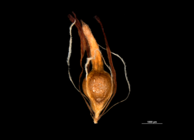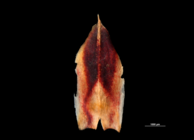Cyperaceae taxon details
Costularia natalensis C.B.Clarke
1679152 (urn:lsid:marinespecies.org:taxname:1679152)
accepted
Species
Tetraria natalensis (C.B.Clarke) T.Koyama · unaccepted
terrestrial
Clarke, C. B. (1894). Cyperaceae. In: Durand, T.; Schinz, H. (eds.), Conspectus floræ Africæ, ou Énumération des plantes d'Afrique. Vol. V, pp. 526-692. Jardin Botanique de l´etat, Bruxelles., available online at https://www.biodiversitylibrary.org/page/29403422
page(s): 658 [details]
page(s): 658 [details]
Lectotype K 000244893, geounit KwaZulu-Natal
Lectotype K 000244893, geounit KwaZulu-Natal [details]
Description Perennial herb up to 2.5 m tall, tufted; rhizome 1–1.5 mm in diameter, woody, erect, clothed in thick adventitious roots....
Distribution Costularia natalensis is restricted in its distribution to southeastern Africa (Fig. 16). In particular, the species is...
Taxonomic remark Source in seed data: wcs Update namepublishedIn from Consp. Fl. Afr. [T.A. Durand & H. Schinz] 5: 685. 1894 [Dec 1894] to...
Description Perennial herb up to 2.5 m tall, tufted; rhizome 1–1.5 mm in diameter, woody, erect, clothed in thick adventitious roots. Culm erect, 50–150 cm tall including inflorescence, 2.5–4.5 mm wide. Basal leaves spirodistichous; leaf sheaths persistent, up to 15 mm wide; leaf blades 30–60 cm × (1.5–)3–4 mm, gradually tapering to elongate curling apices ±1 mm wide, tough, glabrous, margins scabrous. Cauline leaves 2–4. Inflorescence a panicle of closely packed, erect spikelets grouped in ± elongated irregular clusters or appearing interrupted with ± nodding clusters, 55–95 cm long; inflorescence bracts 4–8(–12), dark chestnut brown to blackish-red, reducing in size upwards. Peduncles unequal, up to c. 16 cm long, flattened, scabrid on the margins. Pedicels of the spikelets 2.5–6 mm long, straight to curved, very scabrid. Spikelets oblong, 6–9 × 1.8–2.0 mm, dull dark brown. Glumes subdistichous, 6–12, lower three to nine empty, of which lowest one to three frequently with apex attenuate, remainder increasing in length upwards, apices acuminate or acute, next three largest, 6–7 × 3 mm, boat-shaped, glabrous except for well-marked ciliate margin, apex obtuse, toothed, but rolled so appearing narrow, and almost acute until unfolded, uppermost glume enclosed within the two preceding, slightly shorter. Flowers 2, lower male, upper bisexual. Perianth bristles 6, delicate, six to seven mm long, white, villous in distal half. Stamens 3, filaments persistent five to seven mm long after anthesis, ribbon-like; anthers linear-oblong, large, apiculate, early deciduous. Style trifid, dark brown, coarsely plumose, proximal portion of style persistent as short to long beak on fruit. Nutlet rounded trigonous, narrowed basally into funnel-shaped extension ±1/4 length of globose portion, 5 × 3 mm in total length and width, faintly 3-ridged longitudinally, whitish to pale fawn; surface smooth to slightly transversely rugose. [details]
Distribution Costularia natalensis is restricted in its distribution to southeastern Africa (Fig. 16). In particular, the species is...
Distribution Costularia natalensis is restricted in its distribution to southeastern Africa (Fig. 16). In particular, the species is present at higher elevation (1,070–2,130 m) along the chain of individually isolated highlands roughly paralleling part of the coastline, for example, in South Africa the Wolkberg, Sabie and Graskop areas of the Mpumalanga Drakensberg. Mount Mulanje in Malawi is the northernmost known locality, and the southernmost distribution of the species reaches the area of Pietermaritzburg in Kwazulu-Natal (South Africa). [details]
Taxonomic remark Source in seed data: wcs Update namepublishedIn from Consp. Fl. Afr. [T.A. Durand & H. Schinz] 5: 685. 1894 [Dec 1894] to...
Taxonomic remark Source in seed data: wcs Update namepublishedIn from Consp. Fl. Afr. [T.A. Durand & H. Schinz] 5: 685. 1894 [Dec 1894] to Fl. Cap. 7: 274 (1898), information provided by Alan E. on email Jun. 07 2021 More details could be found in [details]
Cyperaceae Working Group. (2025). [see How to cite]. Global Cyperaceae Database. Costularia natalensis C.B.Clarke. Accessed at: https://cyperaceae.org/aphia.php?p=taxdetails&id=1679152 on 2025-09-14
Date
action
by
2024-12-10 11:47:54Z
unchecked
db_admin
![]() The webpage text is licensed under a Creative Commons
Attribution 4.0 License
The webpage text is licensed under a Creative Commons
Attribution 4.0 License
Nomenclature
original description
Clarke, C. B. (1894). Cyperaceae. In: Durand, T.; Schinz, H. (eds.), Conspectus floræ Africæ, ou Énumération des plantes d'Afrique. Vol. V, pp. 526-692. Jardin Botanique de l´etat, Bruxelles., available online at https://www.biodiversitylibrary.org/page/29403422
page(s): 658 [details]
basis of record Plants of the World Online (POWO). , available online at https://powo.science.kew.org/ [details]
page(s): 658 [details]
basis of record Plants of the World Online (POWO). , available online at https://powo.science.kew.org/ [details]
 Present
Present  Inaccurate
Inaccurate  Introduced: alien
Introduced: alien  Containing type locality
Containing type locality
Lectotype K 000244893, geounit KwaZulu-Natal [details]
From editor or global species database
Description Perennial herb up to 2.5 m tall, tufted; rhizome 1–1.5 mm in diameter, woody, erect, clothed in thick adventitious roots. Culm erect, 50–150 cm tall including inflorescence, 2.5–4.5 mm wide. Basal leaves spirodistichous; leaf sheaths persistent, up to 15 mm wide; leaf blades 30–60 cm × (1.5–)3–4 mm, gradually tapering to elongate curling apices ±1 mm wide, tough, glabrous, margins scabrous. Cauline leaves 2–4. Inflorescence a panicle of closely packed, erect spikelets grouped in ± elongated irregular clusters or appearing interrupted with ± nodding clusters, 55–95 cm long; inflorescence bracts 4–8(–12), dark chestnut brown to blackish-red, reducing in size upwards. Peduncles unequal, up to c. 16 cm long, flattened, scabrid on the margins. Pedicels of the spikelets 2.5–6 mm long, straight to curved, very scabrid. Spikelets oblong, 6–9 × 1.8–2.0 mm, dull dark brown. Glumes subdistichous, 6–12, lower three to nine empty, of which lowest one to three frequently with apex attenuate, remainder increasing in length upwards, apices acuminate or acute, next three largest, 6–7 × 3 mm, boat-shaped, glabrous except for well-marked ciliate margin, apex obtuse, toothed, but rolled so appearing narrow, and almost acute until unfolded, uppermost glume enclosed within the two preceding, slightly shorter. Flowers 2, lower male, upper bisexual. Perianth bristles 6, delicate, six to seven mm long, white, villous in distal half. Stamens 3, filaments persistent five to seven mm long after anthesis, ribbon-like; anthers linear-oblong, large, apiculate, early deciduous. Style trifid, dark brown, coarsely plumose, proximal portion of style persistent as short to long beak on fruit. Nutlet rounded trigonous, narrowed basally into funnel-shaped extension ±1/4 length of globose portion, 5 × 3 mm in total length and width, faintly 3-ridged longitudinally, whitish to pale fawn; surface smooth to slightly transversely rugose. [details]Distribution Costularia natalensis is restricted in its distribution to southeastern Africa (Fig. 16). In particular, the species is present at higher elevation (1,070–2,130 m) along the chain of individually isolated highlands roughly paralleling part of the coastline, for example, in South Africa the Wolkberg, Sabie and Graskop areas of the Mpumalanga Drakensberg. Mount Mulanje in Malawi is the northernmost known locality, and the southernmost distribution of the species reaches the area of Pietermaritzburg in Kwazulu-Natal (South Africa). [details]
Ecology Ppopulations are mostly very localised, often small, and in KwaZulu-Natal, frequently limited to a few scattered, solitary plants which grow on steep, rocky slopes, associated with coarse grasses in the zone between forest and grassland. A slightly more extensive population grows along banks of small streams and among boulders, where nutrients particularly phosphates are in short supply and other vegetation is scare (Restionaceae and short grasses), in the Chimanimani National Park (Zimbabwe). In Mozambique, several (small) subpopulations are also found on quartzite sandstone in the Chimanimani Mts, and on rocks in the submontane grasslands of Mt Gorongosa and Serra Choa. Plants of this species have been collected from Mount Mulanje in Malawi (which is composed of seynite, quartz-seyinite and granite rock materials), in particular from the eastern zone of the Biosphere Reserve (Lichenya and Chambe). It is restricted to higher elevations.
Flowering/fruiting specimens were collected from November to May. [details]
Taxonomic remark Source in seed data: wcs Update namepublishedIn from Consp. Fl. Afr. [T.A. Durand & H. Schinz] 5: 685. 1894 [Dec 1894] to Fl. Cap. 7: 274 (1898), information provided by Alan E. on email Jun. 07 2021 More details could be found in [details]
To Biodiversity Heritage Library (1 publication) (from synonym Tetraria natalensis (C.B.Clarke) T.Koyama)
To Biodiversity Heritage Library (5 publications)
To European Nucleotide Archive, ENA (Costularia natalensis)
To GBIF, Royal Botanic Gardens, Kew (Costularia natalensis K000244893 lectotype 1)
To GenBank (10 nucleotides; 3 proteins)
To GenBank (10 nucleotides; 3 proteins) (from synonym Tetraria natalensis (C.B.Clarke) T.Koyama)
To International Plant Names Index (IPNI) (from synonym Tetraria natalensis (C.B.Clarke) T.Koyama)
To International Plant Names Index (IPNI)
To IUCN Red List (Least Concern)
To Plants of the World Online
To Plants of the World Online (from synonym Tetraria natalensis (C.B.Clarke) T.Koyama)
To Royal Botanic Gardens, Kew (Costularia natalensis K000244893 lectotype 1)
To Biodiversity Heritage Library (5 publications)
To European Nucleotide Archive, ENA (Costularia natalensis)
To GBIF, Royal Botanic Gardens, Kew (Costularia natalensis K000244893 lectotype 1)
To GenBank (10 nucleotides; 3 proteins)
To GenBank (10 nucleotides; 3 proteins) (from synonym Tetraria natalensis (C.B.Clarke) T.Koyama)
To International Plant Names Index (IPNI) (from synonym Tetraria natalensis (C.B.Clarke) T.Koyama)
To International Plant Names Index (IPNI)
To IUCN Red List (Least Concern)
To Plants of the World Online
To Plants of the World Online (from synonym Tetraria natalensis (C.B.Clarke) T.Koyama)
To Royal Botanic Gardens, Kew (Costularia natalensis K000244893 lectotype 1)








